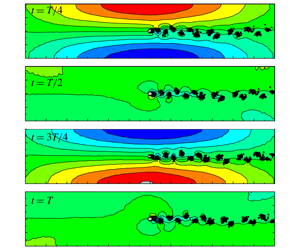Crossref Citations
This article has been cited by the following publications. This list is generated based on data provided by
Crossref.
Islam, Md Rashidul
Shaaban, Mahmoud
and
Mohany, Atef
2020.
Vortex dynamics and acoustic sources in the wake of finned cylinders during resonance excitation.
Physics of Fluids,
Vol. 32,
Issue. 7,
Shaaban, Mahmoud
and
Mohany, Atef
2020.
Experimental study of the self-excited resonance effect on the dynamic lift and flow structure around inline cylinders.
Journal of Fluids and Structures,
Vol. 96,
Issue. ,
p.
103015.
Hong, Zhiliang
Wang, Xiaoyu
Jing, Xiaodong
and
Sun, Xiaofeng
2020.
Vortex sound interaction in acoustic resonance of a flow duct containing a plate.
Journal of Sound and Vibration,
Vol. 483,
Issue. ,
p.
115482.
Cheng, Long
Du, Lin
Wang, Xiaoyu
and
Sun, Xiaofeng
2021.
Inviscid Nonlinear Modeling of Vibration-Induced Acoustic Resonance of a Linear Cascade.
AIAA Journal,
Vol. 59,
Issue. 5,
p.
1849.
Shaaban, Mahmoud
and
Mohany, Atef
2021.
Synchronous vortex shedding from aerodynamically isolated side-by-side cylinders imposed by flow-excited resonant acoustic modes.
Experiments in Fluids,
Vol. 62,
Issue. 10,
Hong, Zhiliang
Yu, Zengze
and
Liu, Limei
2021.
Simultaneous Solution for Vortex and Sound of Cavity Oscillation Based on a Meshless Model.
Journal of Aerospace Engineering,
Vol. 34,
Issue. 4,
Sun, Xiaofeng
and
Wang, Xiaoyu
2021.
Fundamentals of Aeroacoustics with Applications to Aeropropulsion Systems.
p.
207.
Surendran, Aswathy
Na, Wei
Boakes, Charles
Yang, Dong
Morgans, Aimee
and
Boij, Susann
2022.
A low frequency model for the aeroacoustic scattering of cylindrical tube rows in cross-flow.
Journal of Sound and Vibration,
Vol. 527,
Issue. ,
p.
116806.
Zhang, Hou-sheng
Chen, Guang-hao
Wu, Qin
and
Huang, Biao
2022.
Experimental investigation of unsteady attached cavitating flow induced pressure fluctuation.
Journal of Hydrodynamics,
Vol. 34,
Issue. 1,
p.
31.
Shen, Zihan
Wang, Xiaoyu
Sun, Yu
Zhang, Guangyu
and
Sun, Xiaofeng
2022.
Three-dimensional effects of cascade perforations on rotor–stator interaction noise.
Journal of Fluid Mechanics,
Vol. 952,
Issue. ,
Alziadeh, M.
and
Mohany, A.
2022.
Vortex dynamics of tandem bare and spiral finned cylinders in cross-flow and their susceptibility to acoustic resonance excitation.
Physics of Fluids,
Vol. 34,
Issue. 4,
Hong, Zhiliang
Fu, Yilei
Chen, Lingfeng
and
Yang, Mingsui
2023.
Experimental investigation on vortex sound interaction in self-induced acoustic resonance.
Journal of Sound and Vibration,
Vol. 548,
Issue. ,
p.
117510.
LIU, Xiaohua
WU, Zihao
SI, Changxin
YANG, Jun
and
SUN, Xiaofeng
2023.
Role of unsteady tip leakage flow in acoustic resonance inception of a multistage compressor.
Chinese Journal of Aeronautics,
Vol. 36,
Issue. 10,
p.
165.
Alziadeh, M.
and
Mohany, A.
2023.
Flow structure and aerodynamic forces of finned cylinders during flow-induced acoustic resonance.
Journal of Fluids and Structures,
Vol. 119,
Issue. ,
p.
103887.
Fang, Yibo
Du, Lin
He, Chen
Sun, Dakun
and
Sun, Xiaofeng
2023.
Onset of unsteadiness in the flow past a blade cascade.
Physics of Fluids,
Vol. 35,
Issue. 2,
Liu, Rubing
Lin, Ruixin
Chen, Zefan
and
Lin, Qi
2024.
Experimental Study of the Vibration of Blades Induced by Flow and Sound in a Plane Cascade under Low Wind Speed.
Journal of Aerospace Engineering,
Vol. 37,
Issue. 4,
Zhao, Lixuan
and
Li, Qiusheng
2024.
Acoustic effects on aerodynamic characteristics of a surface-mounted square cylinder.
Physics of Fluids,
Vol. 36,
Issue. 12,
Zhao, Lixuan
Li, Qiusheng
and
Wang, Xincong
2024.
Effects of sound on bluff body aerodynamic characteristics in separated and reattaching flows.
Physics of Fluids,
Vol. 36,
Issue. 10,
Shen, Zihan
Wang, Xiaoyu
Li, Jia
Zhang, Guangyu
and
Sun, Xiaofeng
2025.
Acoustic resonance in annular cascades in the presence of background mean flow.
Journal of Fluid Mechanics,
Vol. 1006,
Issue. ,
Wang, Peng
Qiang, Xu
Sung, Hyung Jin
and
Liu, Yingzheng
2025.
Data assimilation for turbulence-merged channel branches with the simultaneous enhancement of hydrodynamics and aeroacoustics.
Journal of Fluids and Structures,
Vol. 134,
Issue. ,
p.
104283.

 $(f_{s})$ and the inherent frequency of the acoustic
$(f_{s})$ and the inherent frequency of the acoustic  $\unicode[STIX]{x1D6FD}$-mode
$\unicode[STIX]{x1D6FD}$-mode  $(f_{a})$. The mutual capturing behaviour of these two frequencies is dominated by
$(f_{a})$. The mutual capturing behaviour of these two frequencies is dominated by  $f_{a}$. Moreover,
$f_{a}$. Moreover,  $f_{s}$ cannot always be locked onto
$f_{s}$ cannot always be locked onto  $f_{a}$ within the whole lock-in region, which is in marked contrast to the previous understanding. In this aspect, two lock-in regions, the synchronous region and the
$f_{a}$ within the whole lock-in region, which is in marked contrast to the previous understanding. In this aspect, two lock-in regions, the synchronous region and the  $\unicode[STIX]{x1D6FD}$-mode dominant region, are defined according to the relevance of
$\unicode[STIX]{x1D6FD}$-mode dominant region, are defined according to the relevance of  $f_{s}$ and
$f_{s}$ and  $f_{a}$. The maximum resonant sound appears at the end of the synchronous region. The present model not only predicts the proper characteristics of frequency lock-in as observed in experiments, but also helps to provide a more detailed understanding of the underlying lock-in mechanism.
$f_{a}$. The maximum resonant sound appears at the end of the synchronous region. The present model not only predicts the proper characteristics of frequency lock-in as observed in experiments, but also helps to provide a more detailed understanding of the underlying lock-in mechanism.